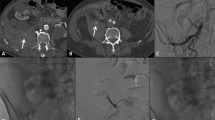Abstract
Purpose
To study a new technique for cleaning microcatheters for reuse after NBCA embolization (“NBCA”), and to evaluate the clinical reusability of microcatheters that were cleaned with gelatin sponge particles after NBCA.
Materials and methods
Four cleaning solution flushes for microcatheters after NBCA injection—5 % glucose (“glucose”) only, Lipiodol–glucose, gelatin sponge particles (“gelatin”)–glucose, and Lipiodol–gelatin–glucose—were examined experimentally. These solutions were evaluated by performing three examinations: a microcatheter resistance test based on the time taken to pass water through the microcatheter, a microcatheter resistance test based on the ease of insertion of a microguidewire, and observations of the inner surfaces of the cylinders after NBCA. Microcatheters that had already been used in NBCA were cleaned using this new technique and then applied in 20 clinical sessions (19 patients).
Results
There was no significant difference in water passage time between the controls and the groups that received a gelatin flush. In the resistance test based on the insertion of a microguidewire, groups that received a gelatin flush showed significantly less resistance than the groups that did not receive a gelatin flush. Observations of the inner surfaces of the cylinders indicated that cleaning with gelatin can lead to inner surfaces that are almost indistinguishable from control surfaces in terms of cleanliness. All clinical procedures involving Lipiodol–gelatin–glucose flushes were performed without any technical difficulties or complications.
Conclusions
Applying the new cleaning technique utilizing gelatin sponge particles to microcatheters after NBCA ensures that they are clean enough to be reused.





Similar content being viewed by others
References
The n-BCA Trial Investigators. N-butyl cyanoacrylate embolization of cerebral arteriovenous malformations: results of a prospective, randomized, multi-center trial. Am J Neuroradiol. 2002;23:748–55.
Brothers MF, Kaufmann JC, Fox AJ, Deveikis JP. n-Butyl 2-cyanoacrylate—substitute for IBCA in interventional neuroradiology: histopathologic and polymerization time studies. AJNR Am J Neuroradiol. 1989;10:777–86.
Numan F, Cakirer S, Islak C, Ogut G, Kadioglu A, Cayan S, Tellaloglu S. Posttraumatic high-flow priapism treated by N-butyl-cyanoacrylate embolization. Cardiovasc Intervent Radiol. 1996;19:278–80.
Kish JW, Katz MD, Marx MV, Harrell DS, Hanks SE. N-butyl cyanoacrylate embolization for control of acute arterial hemorrhage. J Vasc Interv Radiol. 2004;15:689–95.
Pollak JS, White RI Jr. The use of cyanoacrylate adhesives in peripheral embolization. J Vasc Interv Radiol. 2001;12:907–13.
Razavi MK, Murphy K. Embolization of bronchial arteries with N-butyl cyanoacrylate for management of massive hemoptysis: a technical review. Tech Vasc Interv Radiol. 2007;10:276–82.
Mavili E, Donmez H, Ozcan N, Akcali Y. Endovascular treatment of lower limb penetrating arterial traumas. Cardiovasc Intervent Radiol. 2007;30:1124–9.
Stavropoulos SW, Park J, Fairman R, Carpenter J. Type 2 endoleak embolization comparison: translumbar embolization versus modified transarterial embolization. J Vasc Interv Radiol. 2009;20:1299–302.
Yamagami T, Nakamura T, Yamazaki T, Lida S, Kato T, Nishimura T. Catheter-tip fixation of a percutaneously implanted port-catheter system to prevent dislocation. Eur Radiol. 2002;12:443–9.
Stoesslein F, Ditscherlein G, Romaniuk PA. Experimental studies on new liquid embolization mixtures (histoacryl–lipiodol, histoacryl–panthopaque). Cardiovasc Intervent Radiol. 1982;5:264–7.
Guillevin R, Vallee JN, Cormier E, Lo D, Dormont D, Chiras J. N-butyl 2-cyanoacrylate embolization of spinal dural arteriovenous fistulae: CT evaluation, technical features, and outcome prognosis in 26 cases. AJNR Am J Neuroradiol. 2005;26:929–35.
Jae HJ, Chung JW, Jung AY, Lee W, Park JH. Transcatheter arterial embolization of nonvariceal upper gastrointestinal bleeding with N-butyl cyanoacrylate. Korean J Radiol. 2007;8:48–56.
Lee CW, Liu KL, Wang HP, Chen SJ, Tsang YM, Liu HM. Transcatheter arterial embolization of acute upper gastrointestinal tract bleeding with N-butyl-2-cyanoacrylate. J Vasc Interv Radiol. 2007;18:209–16.
Enokizono M, Sakamoto I, Hayashi H, Sueyoshi E, Uetani M. Use of n-butyl cyanoacrylate in abdominal and pelvic embolotherapy: indications and techniques, complications, and their management. Jpn J Radiol. 2012;30(5):377–85. doi:10.1007/s11604-012-0063-x.
Takeuchi Y, Arai Y, Inaba Y, Sone Y, Takai K, Takeda H, Kin Y, Sasaki F, Ohashi K. A procedure for the reuse of microcatheter on the embolization employing NBC-lipiodol mixture—Lipiodol as a washing material (in Japanese). Jpn J Interv Radiol. 1995;10:69–72.
Araki T, Okada H, Kimura K, Sakamoto H, Ataki T. A multipurpose vascular model system with pulsation (in Japanese). Jpn J Intervnt Radiol. 2010;25:194–8.
Author information
Authors and Affiliations
Corresponding author
Ethics declarations
Conflict of interest
All of the authors of this study declare that they have no conflicts of interest.
Statement of informed consent
Informed consent was obtained from all participants included in this study.
Statement of human and animal rights
All procedures performed in studies involving human participants were carried out in accordance with the ethical standards of the institutional research committee and the 1964 Helsinki Declaration and later amendments of it or comparable ethical standards. All applicable institutional guidelines for the care and use of animals were followed.
About this article
Cite this article
Araki, T., Okada, H. & Onishi, H. Can microcatheters be cleaned for reuse after NBCA embolization? Cleaning technique with gelatin sponge particles. Jpn J Radiol 33, 509–516 (2015). https://doi.org/10.1007/s11604-015-0446-x
Received:
Accepted:
Published:
Issue Date:
DOI: https://doi.org/10.1007/s11604-015-0446-x




